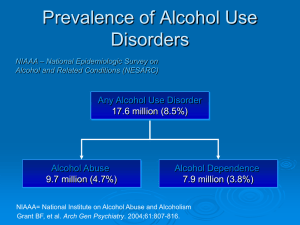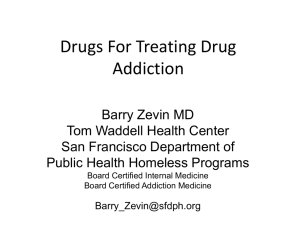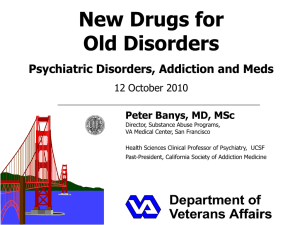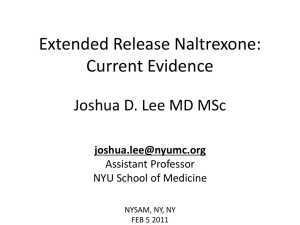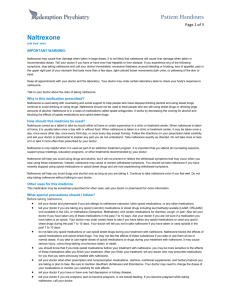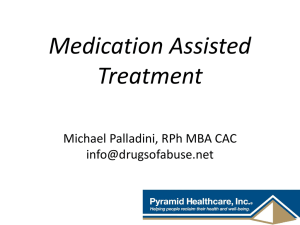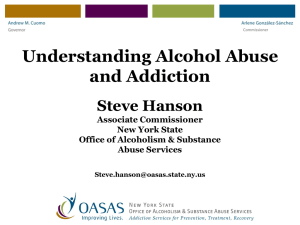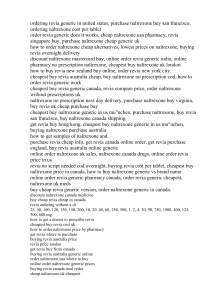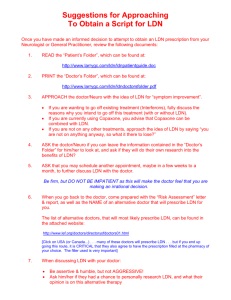Annex I : Agreed CSP
advertisement
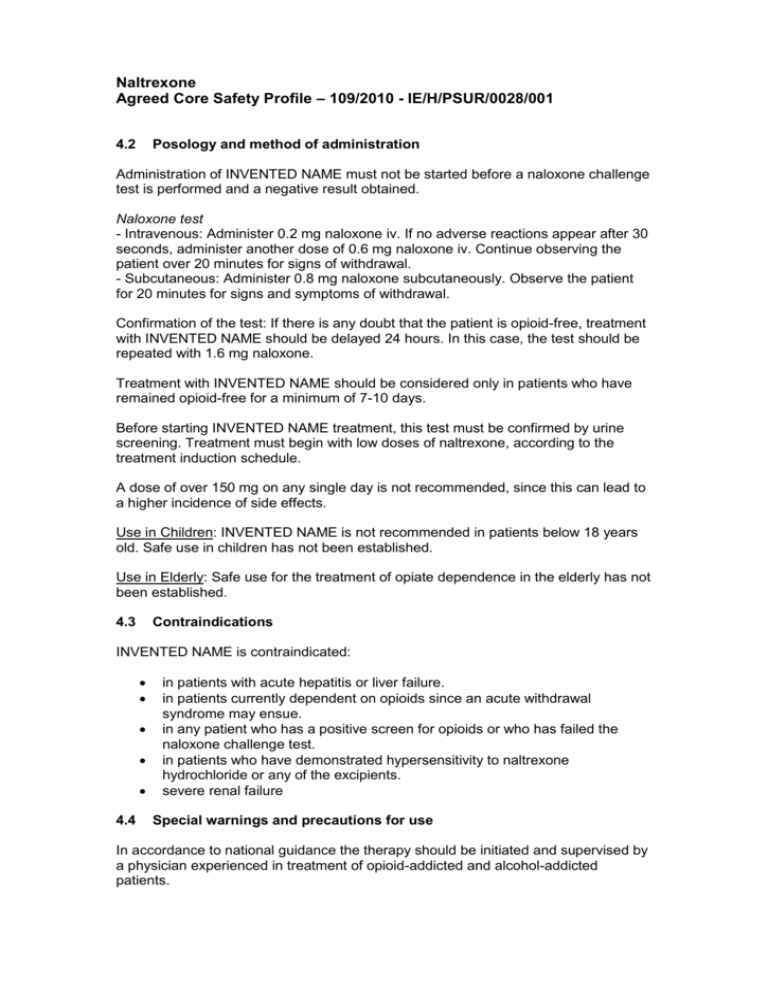
Naltrexone Agreed Core Safety Profile – 109/2010 - IE/H/PSUR/0028/001 4.2 Posology and method of administration Administration of INVENTED NAME must not be started before a naloxone challenge test is performed and a negative result obtained. Naloxone test - Intravenous: Administer 0.2 mg naloxone iv. If no adverse reactions appear after 30 seconds, administer another dose of 0.6 mg naloxone iv. Continue observing the patient over 20 minutes for signs of withdrawal. - Subcutaneous: Administer 0.8 mg naloxone subcutaneously. Observe the patient for 20 minutes for signs and symptoms of withdrawal. Confirmation of the test: If there is any doubt that the patient is opioid-free, treatment with INVENTED NAME should be delayed 24 hours. In this case, the test should be repeated with 1.6 mg naloxone. Treatment with INVENTED NAME should be considered only in patients who have remained opioid-free for a minimum of 7-10 days. Before starting INVENTED NAME treatment, this test must be confirmed by urine screening. Treatment must begin with low doses of naltrexone, according to the treatment induction schedule. A dose of over 150 mg on any single day is not recommended, since this can lead to a higher incidence of side effects. Use in Children: INVENTED NAME is not recommended in patients below 18 years old. Safe use in children has not been established. Use in Elderly: Safe use for the treatment of opiate dependence in the elderly has not been established. 4.3 Contraindications INVENTED NAME is contraindicated: 4.4 in patients with acute hepatitis or liver failure. in patients currently dependent on opioids since an acute withdrawal syndrome may ensue. in any patient who has a positive screen for opioids or who has failed the naloxone challenge test. in patients who have demonstrated hypersensitivity to naltrexone hydrochloride or any of the excipients. severe renal failure Special warnings and precautions for use In accordance to national guidance the therapy should be initiated and supervised by a physician experienced in treatment of opioid-addicted and alcohol-addicted patients. Since naltrexone is extensively metabolised by the liver and excreted predominantly in the urine, caution should be observed in administering the drug to patients with impaired hepatic or renal function. Liver function tests should be carried out both before and during treatment. It is not uncommon for opioid abusing individuals to have impaired liver function. In addition, it is not unusual for alcohol abusers to have altered liver function. Changes in hepatic function tests have been described in obese elderly patients receiving naltrexone at doses higher than recommended (up to 300 mg/day) for the treatment of alcoholism. Liver function tests should be performed before starting treatment and periodically throughout treatment. A withdrawal syndrome may be precipitated by naltrexone in opioid dependent patients; signs and symptoms may develop within 5 minutes and last up to 48 hours. Treatment should be symptomatic and may include opioid administration. A naloxone challenge test is recommended to screen for presence of opioid use; a withdrawal syndrome precipitated by naloxone hydrochloride will be of shorter duration than one precipitated by naltrexone. The naloxone-challenge test should neither be performed in patients with clinically significant withdrawal symptoms nor in patients tested positive for opioids in the urine. Patients should be warned that attempts to overcome the blockade by administering large doses of opioids may result in acute opioid intoxication after the end of the naltrexone effect which may be possibly life threatening. High dose opioid intake, concomitant with naltrexone treatment, can lead to life-threatening opioid poisoning from respiratory and circulatory impairment. Patients must be cautioned about the concomitant use of opioids (e.g. opioids in cough preparations, opioids for symptomatic treatment of colds or opioids in antidiarrhoeal preparations etc.) during treatment with naltrexone. In an emergency situation in which the administration of opioid analgesics is required in patients receiving naltrexone, a higher than usual dose of opioid analgesics may be administered to have the same therapeutic effect. The resulting respiratory depression may be deeper and more prolonged and non-receptor mediated effects may also appear (e.g. swelling of the face, pruritus, generalized erythema, diaphoresis, and other dermal and mucosal symptoms presumably due to histamine liberation). In these circumstances, the patient must be carefully monitored by trained personnel in a hospital center. The risk of suicide is known to increase in substance abusers, with or without concomitant depression. Treatment with naltrexone does not eliminate this risk. Lactose: Patients with the rare hereditary galactose intolerance, lactase deficiency or glucose-galactose malabsorption should not take INVENTED NAME. 4.5 Interaction with other medicinal products and other forms of interaction Presently, clinical experience and experimental data on the effect of naltrexone on the pharmacokinetics of other substances are limited. Concomitant treatment with naltrexone and other medicinal products should be conducted with caution and should be followed carefully. No interaction studies have been performed. In vitro studies have shown that neither naltrexone nor its main metabolite 6-ßnaltrexol is metabolised via human CYP450 enzymes. Therefore it is unlikely that the pharmacokinetics of naltrexone is affected by cytochrome P450 enzyme inhibiting drugs. Sedative products: opioid derivatives (analgesics, antitussives, substitution treatments), neuroleptics, barbiturates, benzodiazepins, anxiolytics others than benzodiazepins (i.e meprobamate), hypnotics, sedative antidepressants (amitriptyline, doxepin, mianserin, trimipramine), sedative antihistaminics H1, central antihypertensives, baclofen, thalidomide. Association not recommended: agonist opioid analgesics; agonist-antagonist opioids; opioids in substitution treatment Association to be taken into account: barbiturates; benzodiazepines Until now no interaction between cocaine and naltrexone hydrochloride has been described. Data from a safety and tolerability study of the co-administration of naltrexone with acamprosate in non-treatment seeking, alcohol dependent individuals showed that naltrexone administration significantly increased acamprosate plasma level. Interaction with other psychopharmacological agents (e.g. disulfirame, amitryptiline, doxepine, lithium, clozapine, benzodiazepines) have not been investigated. There are no known interactions between naltrexone and alcohol. There have been reports of cases of lethargy and somnolence following concomitant administration of naltrexone and thioridazine. 4.6 Pregnancy and lactation Pregnancy: There are no clinical data on naltrexone hydrochloride use in pregnancy. Data from animal studies have shown reproductive toxicity (see section 5.3). The data are insufficient to establish clinical relevance. The potential risk for humans is unknown. Naltrexone should only be given to pregnant women when, in the judgment of the attending physician the potential benefits outweigh and the possible risk. The use of naltrexone in pregnant alcoholic patients receiving long-term treatment with opiates or substitution treatment with opiates, or in pregnant patients who are opioid-dependent, creates a risk of acute withdrawal syndrome which could have serious consequences for the mother and the foetus (see section 4.4). Naltrexone administration must be suspended if opiate analgesics are prescribed (see section 4.5). Lactation: There are no clinical data on naltrexone HCl use in lactation. It is unknown whether naltrexone or 6-beta-naltrexol is excreted in human breast milk. Breast feeding is not recommended duing naltrexone treatment. 4.7 Effects on ability to drive and use machines INVENTED NAME has minor or moderate influence on the ability to drive and use machines. 4.8 Undesirable effects The following adverse reactions have been reported before and during naltrexone medication: Frequency is defined using the following convention: very common (>1/10); common (>1/100, <1/10); uncommon (>1/1,000, <1/100); rare (>1/10,000, <1,000); very rare (<1/10,000). The side effects observed with naltrexone appear to be similar in both alcoholics and patients dependent on opioids. Serious adverse reactions are unusual. Blood and lymphatic system disorders Uncommon: lymphadenopathy Rare: idiopathic thrombocytopenic purpura Psychiatric disorders Very common: nervousness, anxiety, insomnia Common: irritability, affective disorders Uncommon: hallucination, confusional state, depression, paranoïa, disorientation, nightmare, agitation, libido disorder, abnormal dreams Rare: suicidal ideation, attempted suicide Nervous system disorders Very common: headache, restlessness Common: dizziness Uncommon: tremor, somnolence, headache Eye disorders Common: lacrimation increased Uncommon: vision-blurred, eye irritation, photophobia, eye swelling, eye pain or asthenopia Cardiac disorders Common: tachycardia, palpitations, electrocardiogram change Uncommon: palpitation Vascular disorders Uncommon: blood pressure fluctuation, flushing Respiratory disorders Common: chest pain Uncommon: nasal congestion, nasal discomfort, rhinorrhea, sneezing, oropharyngeal pain, sputum increased, sinus disorder, dyspnoea, dysphonia, cough, yawning Gastrointestinal disorders Very common: abdominal pain, nausea and/ or vomiting Common: diarrhoea, constipation Uncommon: flatulence, haemorrhoids, ulcer, dry mouth Hepatobiliary disorders Uncommon: liver disorder, blood bilirubin increased, hepatitis (During treatment an increase of liver transaminases may occur. After discontinuation of naltrexone the transaminases decreased to baseline within several weeks.) Skin and subcutaneous tissue disorders Common: rash Uncommon: seborrhoea, pruritus, acne, alopecia Musculoskeletal and connective tissue disorders Very common: arthralgia and myalgia Very rare: rhabdomyolysis Uncommon: groin pain Reproductive system and breast disorders Common: ejaculation delayed, erectile dysfunction Renal and urinary tract disorders Uncommon: pollakiuria, dysuria Ear and labyrinth disorders Uncommon: ear discomfort, ear pain, tinnitus, vertigo Infections and infestations Uncommon: oral herpès, tinea pedis Metabolism and nutrition disorders Common: decreased appetite General disorders Very common: asthenia Common: thirst, energy increased, chills, hyperhidrosis Uncommon: increased appetite, weight loss, weight gain, pyrexia, pain, peripheral coldness, feeling hot 4.9 Overdose There is limited clinical experience with naltrexone overdose in patients. There was no evidence of toxicity in volunteers receiving 800 mg/day for seven days, however, in case of overdose, patients should be monitored and treated symptomatically in a closely supervised environment. 5.3 Preclinical safety data Naltrexone has been shown to have an embryocidal effect in the rat and rabbit when given in doses approximately 140 times the human therapeutic dose (see section 4.6).
